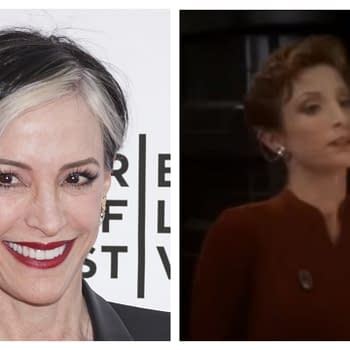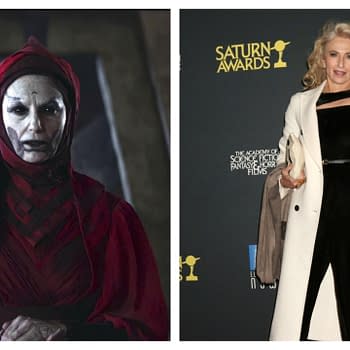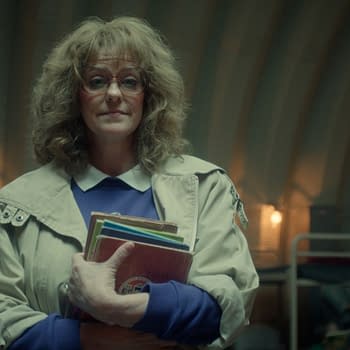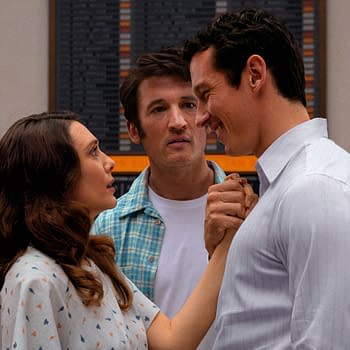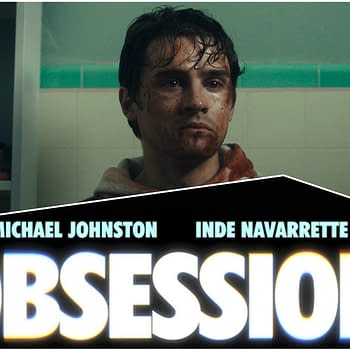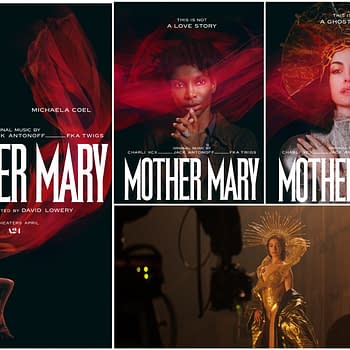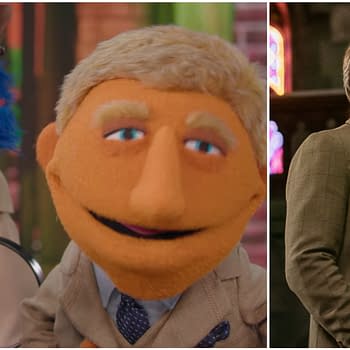Posted in: Exclusive, Horror, Interview, Lionsgate, Movies | Tagged: exclusive, interview, Kevin Greutert, lionsgate, Nick Matthews, saw x, Shawnee Smith, tobin bell
Saw X Cinematographer on Recreating Earlier Films in the Digital Age
Cinematographer Nick Matthews (Mob Land) talks to Bleeding Cool to break down how he and director recreated the earlier films for Saw X.
Nick Matthews owes his career to his love of films, and one of the franchises that helped take him in that direction is the Saw franchise. While the cinematographer admitted not always keeping track of the franchise in recent years, his passion during its early years, starting with the 2004 original, was more than enough for director Kevin Greutert to help expand the second and third films' narrative in the latest in Lionsgate's Saw X. The film reunites franchise star Tobin Bell, reprising his role as John Kramer aka Jigsaw, and Shawnee Smith, reprising her role as his protégé Amanda Young. One of the biggest hurdles for Greutert and Matthews to overcome is recreating the look of the early films that weren't in the digital age using modern tricks. Matthews spoke to Bleeding Cool about the technical changes he had to work with and how Greutert's experience in the early films replaced any need to consult with original writers Leigh Whannell and director James Wan.
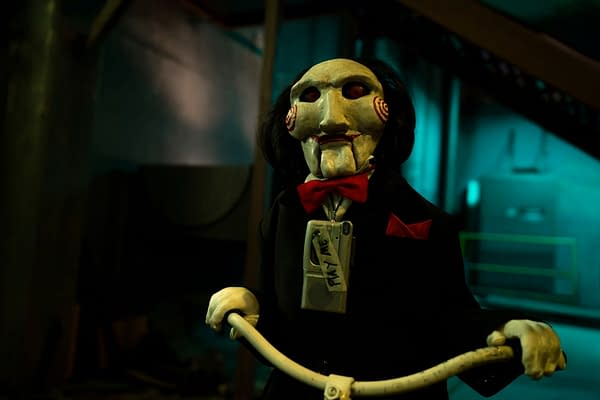
Saw X: Recreating the Earlier Films with Modern Technology
Bleeding Cool: It's been 19 years since the original 'Saw' was released. Technology has obviously improved since then. Was there something you could do that the original films couldn't, or did you recreate the conditions the filmmakers had on set for authenticity for 'Saw X?'
Matthews: I always describe 'Saw' as it's 'Seven' (1995) by way of a new metal music video. It's written in the language of exclamation points. It's bold and in-your-face at points. It's subjective, with big camera movements and lighting that tends to be moody, dramatic, and colorful, drawing from the Giallo films. What I looked at and wanted to do one, we're in a digital age now, and I did have a 4K capture mandate on the movie, which meant we were going to shoot digitally. Kevin and Mike [Suta's] digital anyway. He's cut so many movies and comes from the days of [analog] film. That is in the world he wants to go back to, but the digital challenges are so clean, and it's hyper-real where it ends with zeros and ones. When things blow out, there are sharp lines and things like that.
It was how we set this film so that it feels like it lands between 'Saw One' and 'Two.' We chose to go with a 1.85:1 aspect ratio for a boxier frame instead of going widescreen or Cinemascope, getting us the close-ups that we wanted to tell the story. 'Saw' is a world of boxes, and people are in cages or enclosed. There are screens and some vertical aspects to some traps where a boxier aspect ratio would help us. We also shot on the Sunny Venice, a modern cinema camera. Still, we shot at a high ASA to start from a textural, grittier, and grainier place, and then we added more in post-production.
We used vintage lenses but modern lenses with vintage qualities. These are a set of Cooke classic lenses. They had a certain softness, aberration, and vignetting on the edges. That also brought a vintage quality into the picture. I added some filtration to that, called a pearlescent one, adding a slight blooming to the highlights. It softens the skin a little bit, but because we're using such a steep contrast curve and there's grain, it doesn't make it feel glamorous. It gives it a little bit of softening and takes it out of this space of hyperreality into something that feels a little more nostalgic and a little grittier, scuzzier, and more dramatic.
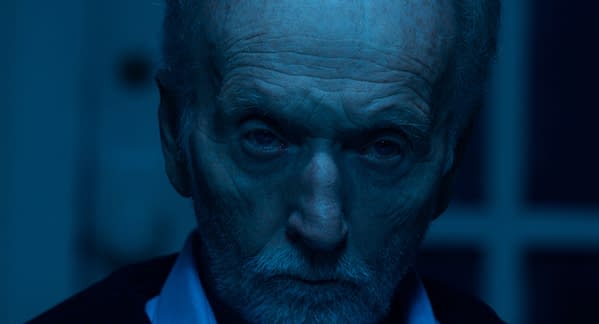
When we harken back to the older films, we're back to some of the circular dolly tracks, the undercranking where it's fast stutter frames. We wanted to bring that back into the photography, and it got away from it in the franchise. Those shots are great for bursts of pain and heightening the drama of the moment. One thing that would be unique to this film was pairing that gritty and grimy aesthetic with us and taking a Giallo approach to the color. The early films have a strong color palette, but it's typically achieved in the eyes with their color grade. You're getting strong colors, but it's monochromatic. The first two movies show a fully green image, a fully yellow, or holy blue. We were taking those colors and doing color separation and middle ground, foreground, and background in a way that allowed those colors to play throughout the film. Because so much of the material is set in one location, many of the previous' Saw' movies tend to have a singular palette for the location you live in, and I didn't want our film to land there. I want our film to have a color arc that develops as the movie goes on. The film starts with more characters, and it's more of a drama at the beginning of the movie, where the colors are more beautiful.
['Saw X' is] a little more scaled back where we use silvery blues, whites, and grays in this American context. Then John goes to Mexico, and we end up with lush green, yellow, red, and gold. There's this beauty to the photography that's a little more Rembrandt and a little less 'Saw.' When the scam happens, we have this fulcrum point in the movie. That's the weight of the operating theater where it takes place. We see much of this material, and then the movie descends into darkness. There's a line in the film where one of the characters asks John Kramer, "Where are you taking me?" He says, "To hell." We pulled some references from 'Dante's Inferno' and from some medieval imagery along the way, but also from Giallo. One of the theoretical approaches I took was if John Kramer's designing these traps, how would he go about designing them? He has a sense of theatricality. It uses puppets and robes. This is all predetermined and pre-designed for these characters, so lighting is also a part of that. What we decided to do was whenever a trap starts, lights come on that are associated with the trap. When a trap ends, the light associated with that trap or above it clicks off. It gives you this naturally evolving kind of color palette within space and the world. If something moves into an emergency, lighting, a look, or things change like that, it allows us to control the color throughout the film. We are landing with these cynical greens, ocher yellows, crimson reds, fluorescent blues, and all this industrial stuff. We're doing it in a way that evolves as the movie does.

When it came to recreating the earlier 'Saw' sets, did you consult with Leigh and James about it, or did you ride Kevin's encyclopedic knowledge and observation?
That's a great question. I would have loved to have talked to them about it, but at this point, they're not involved in the franchise. Kevin had cut the first 'Saw' through 'Five' and had been on set for many of those. It was more of a conversation, and many of those early 'Saw' designs and visual esthetic choices resulted from a lack of money and time. They cut the first movie in three weeks. There are certain jump cuts and stylistic choices made that were a result of our limited resources. Kevin was aware of that, and on the old 'Saws,' they used to do stuff where they would roll out a negative of the film, and we can't do that on our movie since it's digital. Instead, we're making choices where we're shooting six frames a second, 270-degree shutter, and then we're doing lens whacking, where you pop the lens out of the lens mount and bend it around. You get these weird light leaks and stray light and things like that. It wasn't something where we talked to them. It was more something where Kevin and I had a conversation, and as we designed the shot list, we kept those schematic pieces in mind. At the end of the day, we're still trying to tell the story that we're handed and the story in front of us and try to make that the best thing it can be.
Saw X, which also stars Synnøve Macody Lund, Steven Brand, Renata Vaca, and Michael Beach, is in theaters, available on-demand on October 20th, and released on DVD, Blu-ray, and 4K UHD on November 21st.






